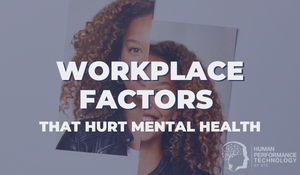Mental Health Terms at Work
The role of the manager (HR and general management) is once again expanding. Supporting people in the context of retention, engagement, motivation and growth has always been a part of these roles - but with growing pressure and levels of uncertainty at work, supporting people is requiring more depth.
This may not have been covered back in business school, but it couldn’t be more important right now. Understanding some basic mental health terms in the context of work can help improve your management practices.
Recent reports have indicated that burnout is on the rise in Australia:
- In the Wellness at Work 2022 Report, 53% of Australians reported feeling burnout.
- According to Elmo Software’s Employee Sentiment Index, 46% of Australian employees admitted they are feeling burnout.
- A global study by Adecco revealed Australian workers are the most burnt out in the world with 53% saying they had suffered from burnout over the past year. (This is higher compared to other Commonwealth countries, such as Canada at 40% and UK at 37%.)
Even though different studies are producing different rates of burnout, one thing they all have in common is that the percentage is higher than in previous years.
What is Burnout?
The World Health Organisation (WHO) defines burnout in its International Classification of Diseases (ICD-11). Burnout is not a medical condition nor mental illness; however, it is considered a factor “influencing health status or contact with health services.”
According to the WHO, burnout is a syndrome resulting from chronic workplace stress that has not been successfully managed. It is characterised by three dimensions:
- feelings of energy depletion or exhaustion;
- increased mental distance from one’s job, or feelings of negativism or cynicism related to one's job; and
- reduced professional efficacy.
The reason burnout is often used in the context of work is, in fact, because burnout refers specifically to the occupational context and should not be applied to describe experiences in other areas of life according to the WHO.
What is Work-Related Stress?
A common element of work is pressure, particularly in a modern workplace. Pressure can help an employee to feel motivated, alert, able to learn and energised; however, if pressure grows and becomes excessive and unmanageable, it can lead to work-related stress.
The WHO defines work-related stress as the response people may have when presented with work demands and pressures that are not matched to their knowledge and abilities and which challenge their ability to cope.
Stress is not a medical condition nor a mental illness, but it can impact one’s overall health.
What is Mental Health versus Mental Illness?
Mental health is an important contributing factor to an individual’s overall health status. Mental health is not merely the absence of mental illness; it is also a state of well-being according to the WHO. The WHO’s definition of mental health includes realising one’s potential, coping with normal life stresses and contributing to one’s community.
Conversely, a mental illness (also referred to as mental ill-health or a mental health disorder) is typically characterised by the presence of symptoms that disrupt one’s ability to function across various aspects of life, including managing relationships and work. In Australia, the three most common mental illnesses are anxiety, depression and substance abuse.
Is Change, Stress and Pressure Just a Part of Work?
For the past two and half years, the volume of changes, stress and pressure has increased. Perhaps then, it’s not a surprise that burnout is on the rise. There are different types of change occurring at work, and the impact on employees has gone unseen and unmeasured.
This was the topic of a free, public webinar that our Head of Consulting recently led for a not-for-profit association. This webinar helps business leaders and change leaders understand the link between organisational change to issues such as pressure, stress and mental ill-health. The full video is available here.
For more on this important topic, you may enjoy our article: Workplace Factors that Hurt Mental Health.
References
Dexter Tilo (April 2022). Nearly half of Australians suffer from burnout, says new ELMO report. Human Resource Director Magazine.
Wellness at Work (2022). Employment Hero.
Adecco (2021). Burnout Might Be The New Worker Pandemic. (Includes link to full report. Can be read in conjunction with Pandemic pushing Aussies to the limit: Australians are the most burnt out in the world.)
World Health Organization. (2019). Burn-out an "occupational phenomenon": International Classification of Diseases.
World Health Organization. (2020). Occupational health: Stress at the workplace.
World Health Organization. (2004). Promoting mental health: concepts, emerging evidence, practice (Summary Report) Geneva: World Health Organization.

Temre Green, PhD
Head of Consulting Services, Australia & New Zealand. Temre has designed, planned and delivered business strategy and transformation programs that were driven by a range of factors, such as innovation, growth, compliance, regulations, restructures and economic downturns. As an Industrial-Organisational Psychologist, Temre has spent her career dedicated to organisational behaviour and the work environment. She is currently focused on the future of work and multiple areas of organisational development that support organisational growth and health.


/Recognising%20the%20Signs%20of%20Mental%20Health.png?width=374&name=Recognising%20the%20Signs%20of%20Mental%20Health.png)
We Would Like to Hear From You (0 Comments)